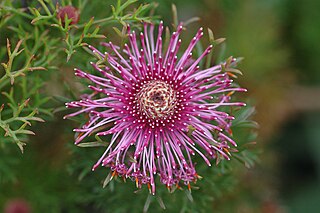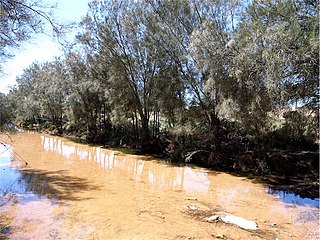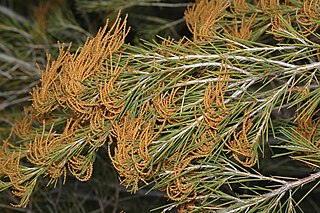
Casuarina equisetifolia, commonly known as coastal she-oak, horsetail she-oak, beach sheoak, beach casuarina or whistling tree is a species of flowering plant in the family Casuarinaceae and is native to Australia, New Guinea, Southeast Asia and India. It is a small to medium-sized, monoecious tree with scaly or furrowed bark on older specimens, drooping branchlets, the leaves reduced to scales in whorls of 7 or 8, the fruit 10–24 mm (0.39–0.94 in) long containing winged seeds (samaras) 6–8 mm (0.24–0.31 in) long.

Allocasuarina, commonly known as sheoak or she-oak, is a genus of flowering plants in the family Casuarinaceae and is endemic to Australia. Plants in the genus Allocasuarina are trees or shrubs with soft, pendulous, green branchlets, the leaves reduced to scale-like teeth. Allocasuarinas are either monoecious or dioecious, the flowers never bisexual. Male and female flowers are arranged in spikes, the female spikes developing into cone-like structures enclosing winged seeds.

Casuarina is a genus of flowering plants in the family Casuarinaceae, and is native to Australia, the Indian subcontinent, Southeast Asia, islands of the western Pacific Ocean, and eastern Africa. Plants in the genus Casuarina are monoecious or dioecious trees with green, pendulous, photosynthetic branchlets, the leaves reduced to small scales arranged in whorls around the branchlets, the male and female flowers arranged in separate spikes, the fruit a cone containing grey or yellowish-brown winged seeds.

Eucalyptus erythronema, commonly known as the red-flowered mallee, is a species of mallee or tree and is endemic to Western Australia. It has smooth, dark pink to red bark that is shed to reveal whitish bark, and has lance-shaped adult leaves, pendulous flower buds mostly arranged in groups of three, red or yellow flowers and conical fruit.

Acacia harpophylla, commonly known as brigalow, brigalow spearwood or orkor, is an endemic tree of Australia. The Aboriginal Australian group the Gamilaraay peoples know the tree as Barranbaa or Burrii. It is found in central and coastal Queensland to northern New South Wales. It can reach up to 25 m (82 ft) tall and forms extensive open-forest communities on clay soils.

Isopogon formosus, commonly known as rose coneflower, is a species of flowering plant in the family Proteaceae and is endemic to the south-west of Western Australia. It is a shrub with divided leaves with cylindrical segments, and spherical to oval heads of pink or red flowers.

Allocasuarina distyla, commonly known as scrub she-oak, is a shrub or small tree of the She-oak family Casuarinaceae endemic to New South Wales.

Casuarina cunninghamiana, commonly known as river oak, river sheoak or creek oak, is a species of flowering plant in the family Casuarinaceae and is native to Australia and New Guinea. It is a tree with fissured and scaly bark, sometimes drooping branchlets, the leaves reduced to scales in whorls of 6 to 10, the fruit 7–14 mm (0.28–0.55 in) long containing winged seeds (samaras) 3–4 mm (0.12–0.16 in) long.

Casuarina glauca, commonly known as swamp she-oak, swamp buloke, swamp she-oak, marsh sheoak, grey she-oak, grey she-oak or guman by the Gadigal people, is a species of flowering plant that is endemic to eastern Australia. It is a dioecious tree that often forms root suckers and has fissured and scaly bark, spreading or drooping branchlets, the leaves reduced to scales in whorls of 12 to 20, the fruit 9–18 mm (0.35–0.71 in) long containing winged seeds (samaras) 3.5–5.0 mm (0.14–0.20 in) long.

Allocasuarina verticillata, commonly known as drooping she-oak or drooping sheoak, is a nitrogen fixing native tree of southeastern Australia.

Casuarina obesa, commonly known as swamp she-oak, swamp oak or western swamp oak, or as goolee, kweela, kwerl and quilinock by the Noongar peoples, is a species of flowering plant in the family Casuarinaceae and is endemic to southern continental Australia. It is a dioecious small tree or shrub that forms root suckers, and has drooping or spreading branchlets, the leaves reduced to scales in whorls of 12 to 16, the fruit 10–20 mm (0.39–0.79 in) long containing winged seeds (samaras) 3–5 mm (0.12–0.20 in) long.

Casuarina cristata, commonly known as belah or muurrgu, is a species of flowering plant in the family Casuarinaceae and is endemic to inland eastern Australia. It is a tree with fissured or scaly bark, sometimes drooping branchlets, the leaves reduced to scales in whorls of 8 to 12, the fruit 13–18 mm (0.51–0.71 in) long containing winged seeds (samaras) 6.0–10.5 mm (0.24–0.41 in) long.

Allocasuarina decussata, commonly known as karri oak or karri she-oak, is a medium-sized tree, or more rarely a shrub, that is endemic to the south west of Western Australia. It is an understory tree in karri forest but also occurs as a stunted shrub in places like Bluff Knoll in the Stirling Range.

Eucalyptus socialis, commonly known as the red mallee, or grey mallee, is a species of mallee that is endemic to inland Australia.

Eucalyptus effusa, commonly known as rough-barked gimlet, is a species of mallee or small tree that is endemic to Western Australia. It has thin, rough bark on the base of the trunk, smooth bark above, linear to narrow lance-shaped adult leaves, flower buds arranged in groups of seven, white flowers and cup-shaped to conical fruit.

Eucalyptus pruinosa, commonly known as silver box, silver leaf box, apple box or smoke tree, is a species of tree or a mallee that is endemic to northern Australia. The Jaminjung peoples know the tree as yarrirra or jarnbiny, the Jaru as wararn and the Wagiman as wararn. It has rough, fibrous to flaky bark on the trunk and branches, a crown composed of juvenile, glaucous, heart-shaped to broadly elliptical leaves arranged in opposite pairs, flower buds arranged in groups of seven on the ends of branches, creamy white to pale yellow flowers and cylindrical to conical fruit.

Allocasuarina acuaria is a species of flowering plant in the family Casuarinaceae and is endemic to the southwest of Western Australia Australia. It is a dioecious shrub that has erect branchlets, the leaves reduced to scales in whorls of four on the ends of the branchlets, the fruiting cones 15–19 mm (0.59–0.75 in) long containing winged seeds (samaras) about 6 mm (0.24 in) long.

Corymbia cadophora, commonly known as twinleaf bloodwood, is a species of small, straggly tree that is endemic to the Kimberley region of Western Australia. It has rough bark on the trunk and branches, a crown of sessile, egg-shaped or lance-shaped leaves joined in opposite pairs, flower buds mostly arranged in groups of seven, creamy white to pink or red flowers and urn-shaped to barrel-shaped fruit.

Leucopogon obovatus is a species of flowering plant in the heath family Ericaceae and is endemic to the southwest of Western Australia. It is an erect shrub with hairy young branchlets, variably-shaped, simple leaves, and erect clusters of 3 to 15 white, bell-shaped flowers on the ends of branches and in upper leaf axils.

Rhadinothamnus rudis is a small shrub with needle-shaped, angular branchlets and single white flowers at the end of branches. This species and the three subspecies are endemic to Western Australia.























